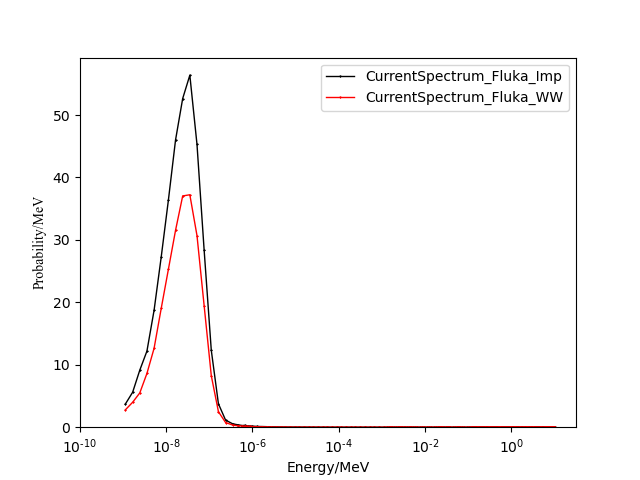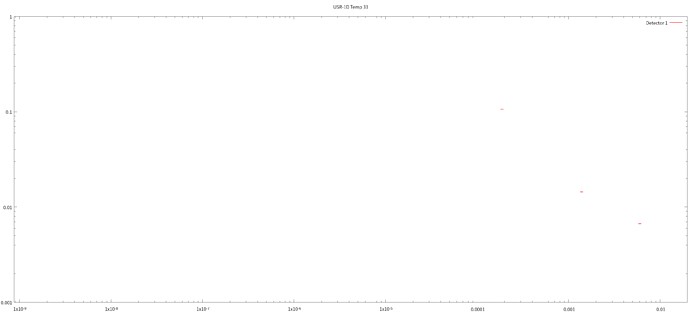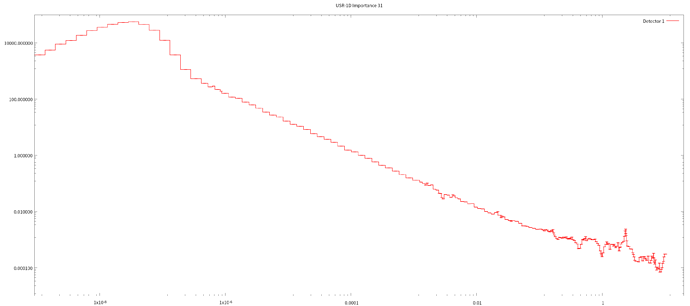i use ww-facto and ww-thres cards to do a simulation of neutron deep penetration, but it seems the two cards do not work.
here is the .inp file:
ww.inp (6.7 KB)
Dear @Newconcept_1979,
Could you please explain what you would like to achieve with your biasing? It is not straightforward to understand it from your input. Also, why do you say that the weight windows are not working?
Additionally, as a general comment, I’d suggest to start using region importance biasing rather than weight windows because it’s of easier implementation.
i want to obtain the neutron current spectrum when10 MeV neutron go through 1.8 m concrete, the case work well when using importance biasing, but not weight window,
as you say, the weight window parameters are not right.
by the way, i set lower weight to 1/2.5 the source region, the next region is divided by 2.5, the upper weight is 5 times than lower weight, something is wrong with this setup?
Dear @Newconcept_1979,
Why do you prefer to use weight window biasing instead of the easier region importance biasing?
Please note as well that for neutrons below 20 MeV, as it is your case, you should also use the WW-PROFIle card for the neutron energy groups.
Lastly, can you provide an argument (e.g. unbiased vs biased) why you say that the weight windows do no work?
Best,
Daniel
@ Daniel Prelipceandprelipc, the reason i prefer to use weight window biasing is that weight window biasing is more powerful than region importance biasing.
i used to add the WW-PROFIle in the case, but nothing happened.
this is the result for 3E+7 primaries without biasing:
this is the result for 3E+7 primaries with weight window biasing:
this is the result for 3E+6 primaries with Importance biasing:
by the way, the result with Importance biasing is almost same wtih the one from Mcnp6.
In the WW-THRES card, you applied the biasing to neutrons above 20 MeV and not to low energy energy neutrons!
In Flair, you should select there the dedicated particle WWLOWNEU, corresponding to the special particle number 40 indicated in the manual.
(Note that WW-PROFI provides additional flexibility but is not mandatory).
when setting upper kinetic energy to the neutron group number 40, but the weight window still is not works.
The neutron group number 40 is not concerned at all, nor the weight window energy limits.
In WW-THRES you selected the particle NEUTRON (that here means neutrons above 20 MeV), you should select instead WWLOWNEU (corresponding to the particle number 40 indicated in the manual).
WW-THRES 1 260 WWLOWNEU WWLOWNEU PRIMARY
This way, with your own input and no other change, the weight windows appear to perfectly work and produce a nice neutron spectrum.
@ Francesco Cerutticeruttif, thank you very much, now the case works well.
but the problem else occurs, the result is different from the one with importance biasing:

by the way, what is the value of the splitting number and/or surriving probabiliy by Russian roulette in weight window biasing?
The one indicated in the manual, note 2:
Russian Roulette is played in a given region if the particle weight is lower than the bottom window edge […]. The particle survives with a probability equal to the ratio between its weight and the RR edge, and is given a new weight equal to the RR edge itself.
Splitting is performed if the particle weight is higher than the top window edge […]. The particle is replaced by two identical ones with half its weight {and so forth}.
Concerning the alleged discrepancy with importance biasing, please upload the respective input file.
here is the .inp file of importance biasing:
Importance.inp (6.7 KB)
Maybe the the splitting number and/or surriving probability is not the good one,
either splitting or Russian roulette should make the particle to obtain the weitht between
“bottom” weight and “top” weight.
Maybe it is good that the splitting number equal to the ratio between “top” weight and “bottom” weight,
and the surriving probability equal to the ratio between “bottom” weight and “top” weight.
This is what they correctly do, taking into proper account the particle weight.
You forgot to add the RANDOMIZe card, so all your cycles give identical results and do not allow you to calculate the statistical error in the resulting spectrum. When including it, you will see that the two curves are compatible within statistical errors.
After adjusting the weight window settings to the same logic as for importance biasing , namely
WW-FACTO 0.003906250.01171875 C8 C8 1
what.1=0.5/(2**7)
what.2=1.5/(2**7)
where the initial 0.5 to 1.5 weight window is scaled down by a factor 2 in each subsequent region, and after running a sufficient number of primaries in either case, you will find that the thermal peak perfectly overlaps, contrary to your figure above.
@ Francesco Cerutti, yes, you are right, thank you very much!


